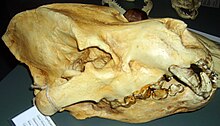Percrocutidae
| Percrocutidae Temporal range: Early Miocene to Late Pliocene
| |
|---|---|

| |
| Dinocrocuta gigantea | |
| Scientific classification | |
| Kingdom: | |
| Phylum: | |
| Class: | |
| Order: | |
| Suborder: | |
| Family: | Percrocutidae Werdelin & Solounias, 1991
|
| Genera | |
Percrocutidae is an extinct family of hyena-like feliform carnivores endemic to Asia, Africa, and Southern Europe from the Miocene through the Pliocene, existing for about 17.41 million years.[1]

The first percrocutids are known from the middle Miocene of Europe and western Asia and belonged to the genus Percrocuta. Percrocuta already had large premolars, but did not carry such a massive bite as the later form Dinocrocuta, from the later Miocene.[2] Originally, these carnivores were placed with the hyenas in the family Hyaenidae. Today, most scientists consider the Percrocutidae to be a distinct family — although usually as sister-taxa/immediate outgroup to Hyaenidae.[3] Sometimes it is placed with carnivoran genera, such as Stenoplesictis, into the family Stenoplesictidae.
Genera
- Percrocuta (including Capsatherium; Middle Miocene to Late Pliocene of Africa, Middle to Late Miocene of Eurasia)
- Dinocrocuta (Middle Miocene of Africa, Middle to Late Miocene of Asia)
The list follows McKenna and Bell's Classification of Mammals for prehistoric genera (1997).[4] In contrast to McKenna and Bell's classification, they are not included as a subfamily into the Hyaenidae but as a separate family Percrocutidae.
References
- ^ Paleobiology Database: Percrocutidae basic information
- ^ Alan Turner & Mauricio Antón: Evolving Eden. An Illustrated Guide to the Evolution of the African Large-Mammal Fauna. Columbia University Press, New York, 2004. ISBN 0-231-11944-5
- ^ Borja Figueirido, Zhijie JACK Tseng, Alberto Martín-Serra, Skull Shape Evolution In Durophagous Carnivorans, Article in Evolution 67(7):1975-93 · July 2013 DOI: 10.1111/evo.12059 · Source: PubMed
- ^ Malcolm C. McKenna, Susan K. Bell: Classification of Mammals: Above the Species Level in Columbia University Press, New York 1997, 631 Seiten, ISBN 0-231-11013-8
- Jordi Agustí: Mammoths, Sabertooths and Hominids 65 Million Years of Mammalian Evolution in Europe, Columbia University Press, 2002. LCCN 2001-42251 ISBN 0-231-11640-3
